
To commemorate Julia Child’s 101st birthday on Taste With The Eyes I am updating a few of my favorite JC posts this week. In addition to the re-creation of Julia Child’s First Meal in France posted on Sunday, today we are sneaking into Julia’s kitchen to watch her make the authentic Caesar Salad and Salmon in Papillote in her usual charming and un-fussy manner.
This story is an adaptation from Julia and Jacques Cooking At Home By Julia Child and Jacques Pépin, published by Alfred A. Knopf, New York 1999. It’s one of my favorite books, Julia and Jacques are adorable together! The book is unique as it gives the perspective from two legendary chefs, who don’t always agree on technique. “Again and again, they demonstrate that cooking is endlessly fascinating and challenging and, while ultimately personal, it is a joy to be shared.”
So, come with me, let’s have a peek into Julia’s kitchen…
In Julia Child’s Kitchen
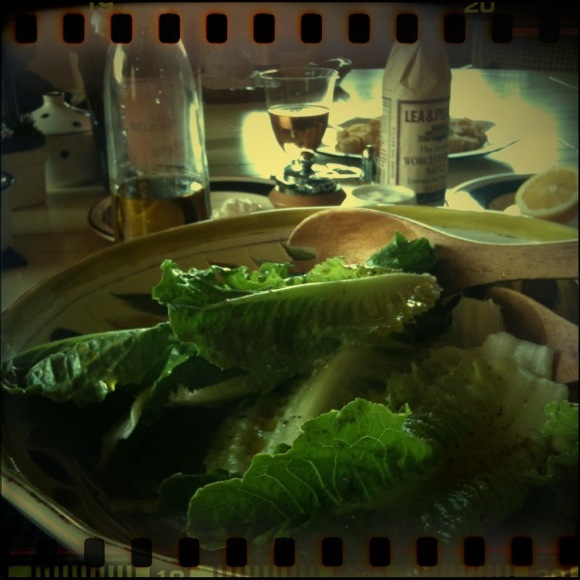
“Today we are going to make a delightful dinner, Caesar Salad and Salmon en Papillote.
Of course, cooking en papillote does not have to be fancy –
it’s a fine method for everyday cooking too.”
“I am probably one of the few people around who saw the real Caesar Cardini making his salad.
I was about 9 when my parents took me to Tijuana, just the other side of the border from San Diego.
They were so excited when big jolly Caesar himself came to the table to make the salad, which had already been written up and talked about everywhere. And it was dramatic, I remember most clearly the eggs going in, and how he tossed the leaves so it looked like a wave turning over.”

“Homemade croutons are essential for our Caesar salad and a fine addition
to a basic green salad as well as soups.”
Slice country style white bread into 1/2″ cubes. Bake in a 350° oven until lightly toasted. Meanwhile crush one large garlic clove with the flat end of chef’s knife, sprinkle 1/4 t. salt. Mince well. Pour 1 T. olive oil on the garlic, mash again with knife, rubbing and pressing to make a soft purée. Scrape purée into a frying pan, add 1 T. olive oil, warm over low-medium heat. Add croutons and toss to infuse with garlic oil.
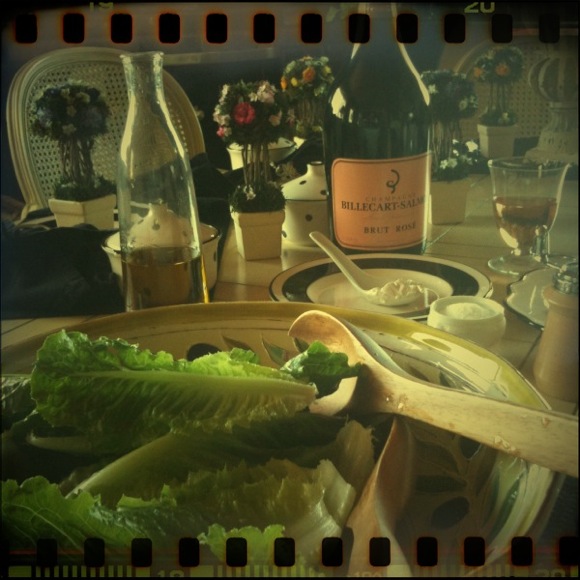
Drizzle olive oil over the romaine leaves and toss to coat, lifting the leaves from the bottom and toward you, so they tumble over like wave. Sprinkle with a generous pinch of salt and several grinds of pepper.
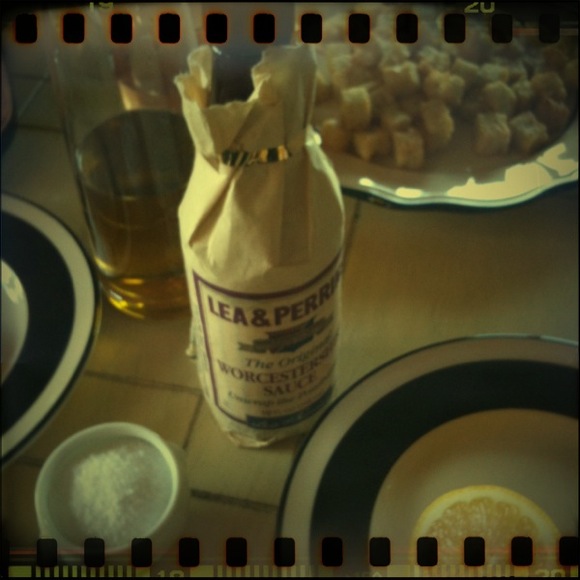
Add fresh squeezed lemon juice and several drops of Worcestershire Sauce, and toss again. Taste for seasoning, add more if needed.
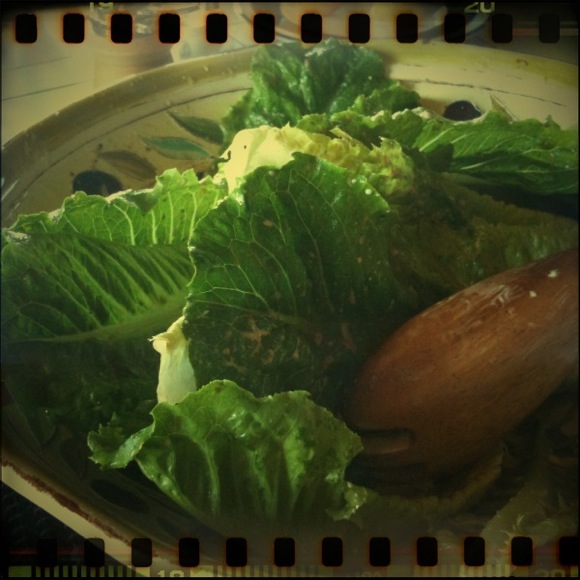
Toss “like a wave” again. Crack a coddled egg and drop it right on to the romaine leaves, then toss to break it up and coat the leaves.
“This version is quite close to the original by Caesar himself, and you can see it is really a very simple salad. Use small tender romaine leaves, real Parmigiano Reggiano – none of that fake stuff – and the one-minute coddled egg for creaminess – although you can substitute a teaspoon of mayonnaise for the egg. But you don’t want herbs or anchovies and things like that – then you have adulterated it.”

Grate fresh Parmigiano -Reggiano and add the croutons. Toss for the last time, just to mix the croutons into the salad.
“When Caesar first served his famous salad in the 1920’s, he used just the hearts of romaine lettuce, the tender short leaves in the center, and he presented them whole. The salad was tossed and dressed, then arranged on each plate so you could pick up a leaf by its short end and chew it down bit by bit, then pick up another.”
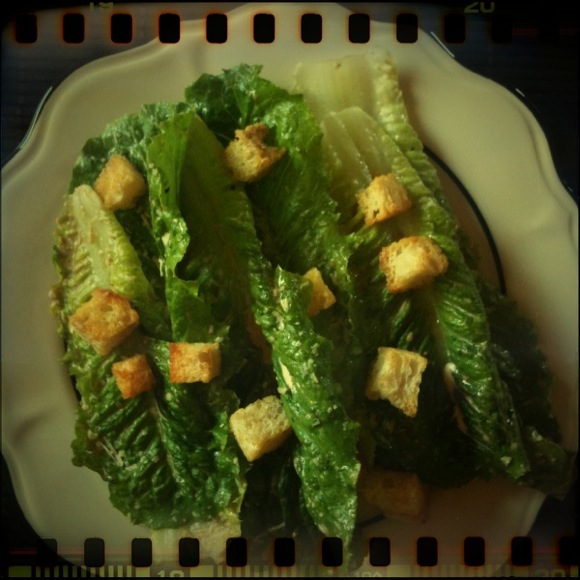
“Many customers didn’t like to get their fingers covered with egg-and-cheese-and-garlic dressing, and he changed to the conventional torn leaf. Too bad, since the salad lost much of its individuality and drama. You can certainly serve it the original way at home – just provide your guests with plenty of big paper napkins.”
“And plan to be extravagant.”
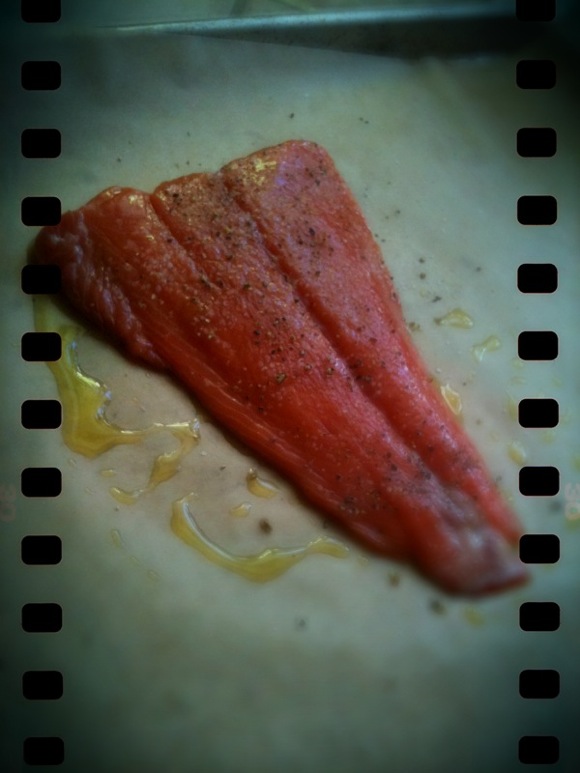
“A classic way to cook a fish filet is to seal it inside a tightly folded package of parchment paper and bake it briefly in a hot oven. Known as en papillote, this gentle method cooks the enclosed fish in its own moisture and creates its own sauce of natural juices.”
“Cooking en papillote is also fun – assembling and wrapping the fish in paper…”
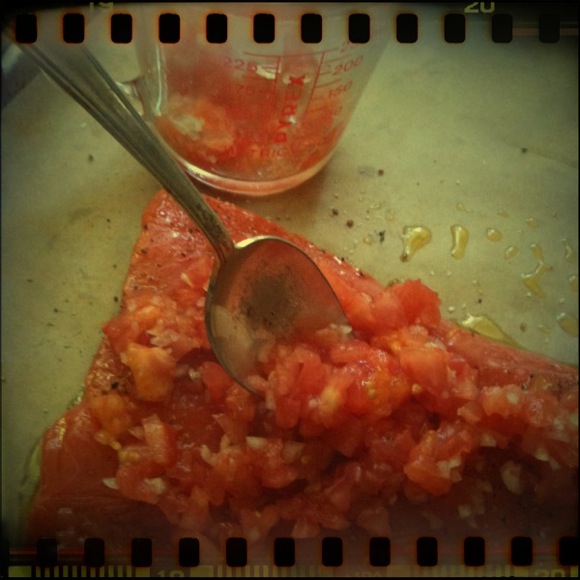
Season each side of the salmon with a big pinch of salt and several grinds of pepper. Place a bit of soft butter {or olive oil} on a piece of 20″ X 15″ parchment paper. Place the fish in the center, its most attractive side up. Top the fish with 1/2 c. diced (peeled & seeded) fresh tomato mixed with 1 T. finely minced shallot.

Scatter parsley leaves over and around the fish.

Lift the shorter sides of the parchment so the edges meet right above the salmon, like a tent. Fold over several times then fold the sides together. Crimp the folds tightly with your fingers, use pins at the end to seal the package completely.

Bake on a cookie sheet in a 425° oven for 8 minutes for a filet less than an inch thick, or 10 minutes for a filet 1 to 1 1/4″ thick. To serve, carefully transfer the package to a dinner plate, remove the pins and simply unfold the parchment.
“It is thrilling to open the package at the table, revealing a beautifully cooked dish releasing all the pent-up aromas in one heady burst.”

Celebrating Julia with roses the color of butter. Naturally.
In Memoriam
JULIA CHILD
August 15, 1912 – August 13, 2004
chef, mentor, heroine, author, television icon, inspiration, nonagenarian, friend
“You don’t have to cook fancy or complicated masterpieces –
just good food from fresh ingredients.” -Julia Child
(UPDATE: Please visit Celebrating Julia Child – Part I JULIA’S FIRST MEAL IN FRANCE here, and Part III LOUP DE MER A LA PROVENCAL here).

It is hard for me to think of a presentation more beautiful . . . . have shared . . .